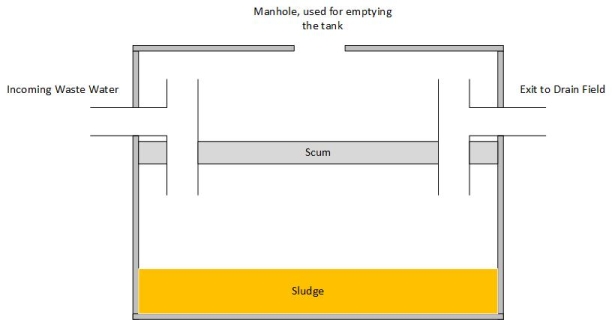Septic systems are used in places without connections to main sewage systems, typically provided by local authorities or private corporations. In North America, about 25 percent of the population relies on septic systems.
A septic system is in essence a small standalone sewage treatment system. It is made up of two main components, the septic tank and the drain field. A septic system is very simple, it has no moving parts. Household waste water enters the septic tank on one side and relatively clean water exists the tank on the opposite side into the drain field. Typically, the septic tank and the drain field are located so that gravity will distribute the liquid from the tank into the field. The need for a drain field means that septic systems are not suitable for densely built areas.

Today, most septic tanks have two chambers. Usually the two compartments are separated by a baffle partition or a wall. The advantage of the two chambers is that the tank does not need to be emptied as frequently as if it had only one chamber. The water exiting the tank and going into the leaching field is relatively clean. Additionally, the soil purifies the waste water before it reaches the groundwater.
Heavy solids in the wastewater settle at the bottom of the tank, forming the sludge layer. Grease and light solids float to the top forming the scum layer. Between the sludge layer and the scum layer is the wastewater, which is slowly being pushed into the drain field. Bacteria break down the sludge and scum in the tank. But they cannot break down all of the sludge and scum, therefore septic tanks have to be emptied once in a while.
A septic tank does not require much maintenance. As mentioned earlier, it just needs to be emptied to avoid solid waste to enter the drain field. A properly sized septic tank should not need to be emptied more than once every ten years or so. Emptied means that the accumulated sludge and scum are pumped out of the tank. What properly sized means depends on a lot of factors making it difficult to estimate the right size. If the septic tank is too small, waste water will be leaving the tank before all solids have been separated or even worse, the sludge layer starts to flow out the tank.
It is worth mentioning that no septic tank additives has been proven to improve performance. Despite the many claims to cut down on the maintenance, no conclusive evidence exist that these products will actually improve the performance of the septic tank.
Garbage disposals put additional strain on septic tanks. They increase the amount of solids entering the tank. This could lead to that solids exit the tank rather than sinking down to the sludge area. Many garbage disposals are said to be “safe for properly sized septic systems.” And that is generally true, a garbage disposer seldom adds much additional strain. On the other hand, if the septic system is already struggling, a garbage disposal will make things worse.